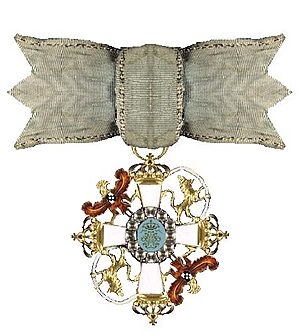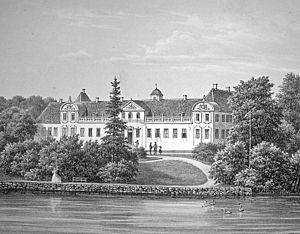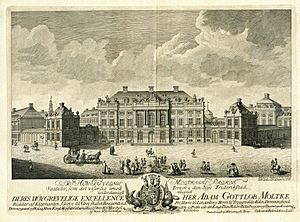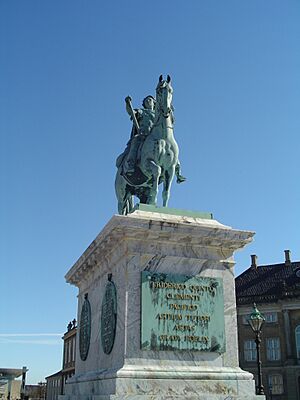Adam Gottlob Moltke facts for kids
Quick facts for kids
Adam Gottlob von Moltke
|
|
|---|---|
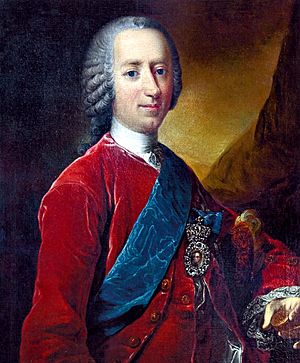
Portrait of Moltke
|
|
| Member of the Privy Council of Denmark |
|
| In office 1747–1766 |
|
| Court Marshal of Denmark | |
| In office 1743–1747 |
|
| Lord Chamberlain of Denmark | |
| In office 1730–1743 |
|
| Personal details | |
| Born | 10 November 1710 Riesenhof, Mecklenburg, Germany |
| Died | 25 September 1792 (aged 81) Haslev, Sjælland, Denmark |
| Spouses | Christiane Frederikke von Brüggemann Sophie Hedevig von Raben |
| Children | Joachim Godske Moltke Ulrikke Augusta Vilhelmine Moltke |
| Parents | Joachim von Moltke Magdalene Sophia von Cothmann |
| Relatives | Adam Wilhelm Moltke (grandson) |
| Residence | Bregentved |
| Awards | Ordre de l'Union Parfaite Fellow of the Royal Society |
Adam Gottlob von Moltke (born 10 November 1710 – died 25 September 1792) was an important person in Denmark during the 1700s. He was born in Germany but became a close friend and advisor to Frederick V of Denmark, who was the King. Moltke was a courtier (someone who serves at a royal court), a statesman (a skilled leader in government), and a diplomat (someone who represents their country in other nations).
His son, Joachim Godske Moltke, and his grandson, Adam Wilhelm Moltke, both later became Prime Ministers of Denmark.
Contents
Early Life and Royal Friendship
Adam Gottlob von Moltke was born in 1710 in Mecklenburg, Germany. Even though his family was German, many of them worked for the Danish royal court. This was a good opportunity for young noblemen from northern Germany.
In 1722, when Moltke was just 12 years old, he became a page at the Danish court. A page is a young servant to a person of high rank. Here, he became very good friends with the crown prince, Frederick. This friendship lasted his whole life. Frederick later became King Frederick V of Denmark.
Working for King Frederick V
When Frederick became King in 1746, he immediately gave Moltke many important jobs and honors. In 1730, Moltke was made Lord Chamberlain. This job was usually just a court position, but Moltke made it very powerful. He was the King's trusted friend and was always by his side. This meant Moltke could share his ideas and influence the King on many different matters.
In 1747, Moltke was given the large estate of Bregentved. In 1750, the King made him a count, which is a high noble title.
Moltke was very influential. Foreign diplomats even said he could decide who became a minister in the government. He supported other important leaders, like Count Johann Hartwig Ernst von Bernstorff, even when others tried to get Bernstorff removed. Moltke believed Bernstorff was the right person for the job.
Moltke helped improve farming in Denmark. He owned a lot of land and worked to make life better for farmers. He also brought in new farming methods and technologies. His most important role was guiding and supporting King Frederick V.
When Queen Louisa died, King Frederick V wanted to marry one of Moltke's daughters. But Moltke politely refused this offer. Instead, Moltke helped arrange a new marriage for the King. Frederick V married Juliana Maria of Brunswick-Wolfenbüttel in 1752.
Changes Under King Christian VII
King Frederick V died in 1766, with Moltke by his side. After Frederick's death, Moltke's influence ended. The new King, Christian VII of Denmark, did not like Moltke. He even made fun of Moltke's tall, thin appearance.
Moltke was also wrongly thought to have taken money from the public. Because of this, he was removed from all his positions in July 1766. He then went to live at his estate in Bregentved.
Later, in 1768, Moltke briefly got his seat back in the council. However, King Christian VII suffered from mental illness. He was heavily influenced by his personal doctor, Johann Friedrich Struensee. Struensee became very powerful and ruled the country from 1770 to 1772.
Moltke was dismissed again in December 1770 because he disagreed with Struensee's liberal ideas. Struensee made many big changes, like ending torture, stopping forced labor, and allowing freedom of the press. He also worked to reform universities and reduce the army. However, Struensee lost public support and was removed from power in 1772. After this, the King's stepmother and half-brother ruled the country.
Personal Life and Family
Adam Gottlob von Moltke was married twice. His first wife was Christiane Frederikke von Brüggemann (1712–1760). After she died, he married Sophie Hedevig von Raben (1732–1802).
Moltke had many children. It is said he had 22 sons between his two wives. Many of his children became important public servants. For example, five of his sons became government ministers, and four became ambassadors.
Some of his notable children include:
- Christian Frederik von Moltke (born 1736)
- Catharine Sophie Wilhelmine Caroline von Moltke (born 1737)
- Ulrikke Augusta Vilhelmine Moltke (born 1740)
- Joachim Godske Moltke (1746–1818)
Adam Gottlob Moltke lived quietly at his estate until he died on 25 September 1792.
Amalienborg Palace
Moltke played a big part in building the Frederiksstaden district in Copenhagen. This area was created to celebrate 300 years of the House of Oldenburg family ruling Denmark. Moltke, along with the royal architect Nicolai Eigtved, led the construction.
The project included building four identical mansions around an octagonal (eight-sided) square. These mansions were for important noble families. Moltke's mansion, built from 1750 to 1754, was the most expensive and had the most beautiful interiors. Its Great Hall was famous for its detailed wood carvings and paintings.
In 1794, the Royal Family needed a new home after Christiansborg Palace burned down. Moltke's mansion and another nearby one were sold to the King. These mansions now form the modern Amalienborg Palace, which is the main residence of the Danish royal family.
Legacy and Contributions
Moltke was a director of the Danish East India Company. In 1753, he asked a French artist named Jacques Saly to create a statue of King Frederik V on horseback. The statue was finished in 1771, five years after the King's death. It stands in the center of the Amalienborg Palace Square today.
Moltke also had a large collection of art in his palace. This collection was later opened for the public to see. He was also chosen as a Fellow of the Royal Society in 1764, which is a very respected group for scientists. His writings about his life are important for understanding Danish history.
See also
 In Spanish: Adam Gottlob Moltke para niños
In Spanish: Adam Gottlob Moltke para niños


